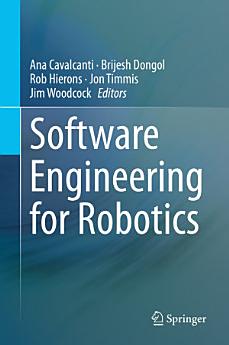Software Engineering for Robotics
ਇਸ ਈ-ਕਿਤਾਬ ਬਾਰੇ
The origin of this book is a two-day event, entitled RoboSoft, that took place in November 2019, in London. Organized with the generous support of the Royal Academy of Engineering and the University of York, UK, RoboSoft brought together more than 100 scientists, engineers and practitioners from all over the world, representing 70 international institutions.
The intended readership includes researchers and practitioners with all levels of experience interested in working in the area of robotics, and software engineering more generally. The chapters are all self-contained, include explanations of the core concepts, and finish with a discussion of directions for further work.
Chapters 'Towards Autonomous Robot Evolution', 'Composition, Separation of Roles and Model-Driven Approaches as Enabler of a Robotics Software Ecosystem' and 'Verifiable Autonomy and Responsible Robotics' are available open access under a Creative Commons Attribution 4.0 International License via link.springer.com.
ਲੇਖਕ ਬਾਰੇ
Brijesh Dongol is a Senior Lecturer at the University of Surrey. His research is on formal techniques and verification methods for concurrent and real-time systems. This includes concurrent objects, transactional memory and associated correctness conditions; weak memory models; algebraic techniques; and hybrid systems. He leads several projects funded by the EPSRC, research institutions and industrial partners and is a member of the Formal Methods Teaching Committee.
Rob Hierons joined The University of Sheffield in 2018 as a full Professor. His research concerns the automated generation of efficient, systematic test suites on the basis of program code, models or specifications. He is joint Editor-in-Chief of the Journal of Software Testing, Verification, and Reliability (STVR) and is a member of the editorial boards of The Computer Journal and Formal Aspects of Computing.
Jon Timmis is Professor of Intelligent and Adaptive Systems at the University of Sunderland, where he is Deputy Vice-Chancellor, and is Visiting Professor at the University of York. His research focuses on biologically-inspired systems and modelling, with applications in robotic and swarm robotic systems as well as computational biology. He has commercialized his research into modelling and simulation in the biosciences. He is a former Royal Society-Wolfs on Research Merit Award holder and a Royal Academy of Engineering Enterprise Fellow.
Jim Woodcock is Professor of Software Engineering at the University of York, known for his research, teaching, and consultancy in the application of industrial-scale software engineering and formal methods. He is a Chartered Engineer, a fellow of the UK Royal Academy of Engineering, and a member of the London Mathematical Society. His current research is in modelling and reasoning about uncertainty in robotic applications.








